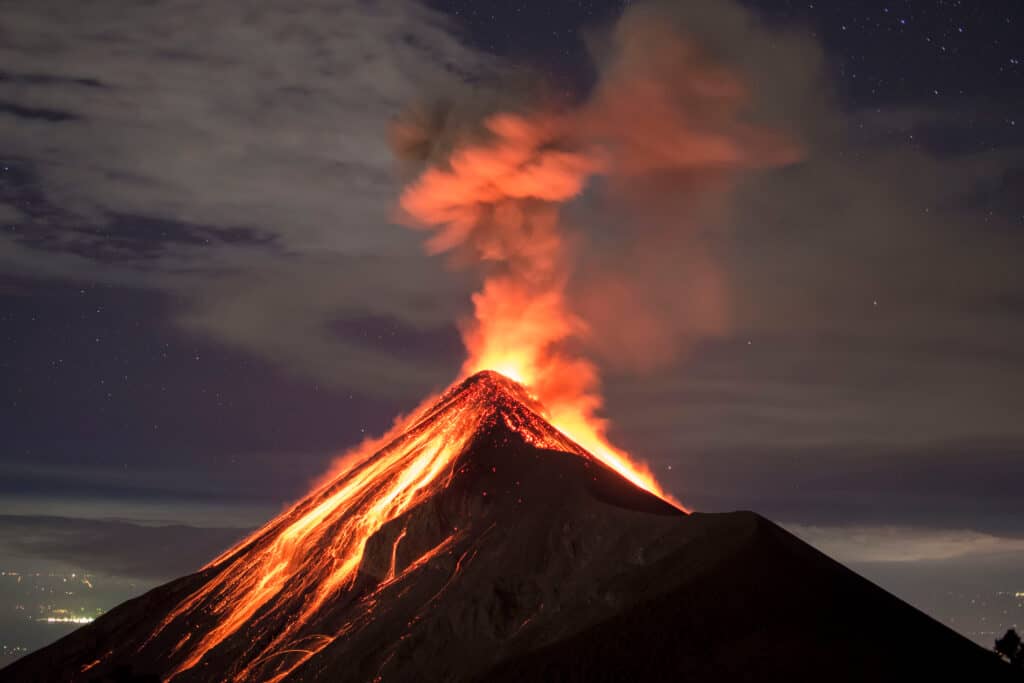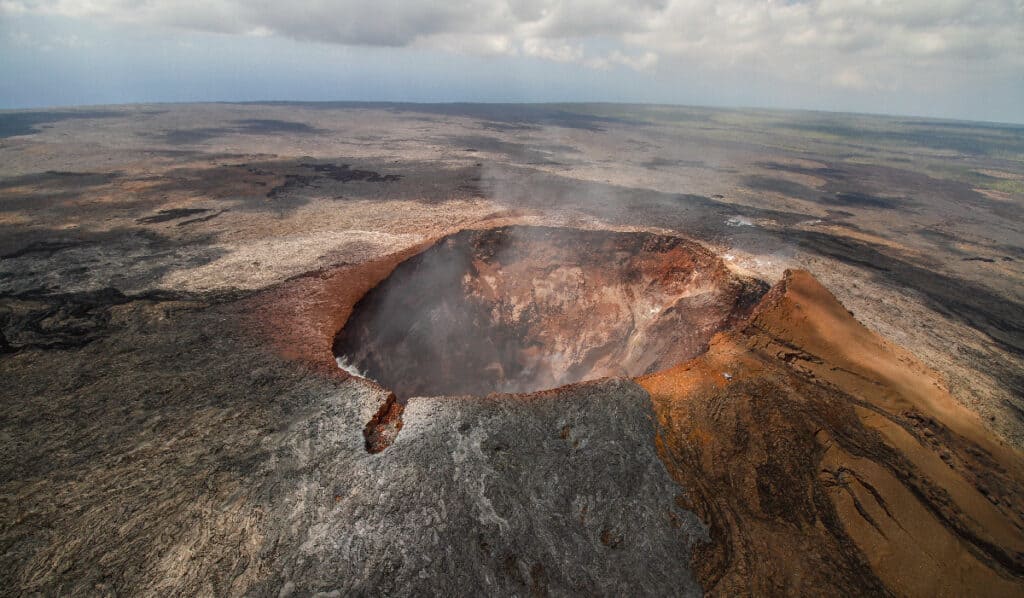Many stunning views exist on Earth than we could ever imagine, scattered over various nations on various continents. There are numerous locations that many individuals will never have the chance to visit in their lifetimes. However, a generic list of the world’s seven natural wonders was compiled in 1997 as a monument to the beauty of the Earth and to highlight a handful of its wonders that are a must-see.
The seven natural wonders are breathtaking illustrations of the Earth’s magnificence. However, you do not need to visit these places to appreciate the planet’s beauty. Other natural world wonders include volcanoes, barrier reefs, and vast vistas. So, what is the largest active volcano on Earth? Let’s find out!
What is a Volcano?

Currently, there are over 1300 volcanoes in the world.
©fboudrias/Shutterstock.com
The best way to define a volcano is as a fissure in the Earth’s surface where lava (molten rocks), volcanic ash, and gaseous substances erupt. The nature of eruptions depends on how the volcano evolves. On random occasions, flowing magma can rise to the surface through conduits in the Earth and may either flow continuously or rise upwards like a dazzling hot spring.
Volcanoes are very similar to geysers, which are also high-temperature eruptions from the Earth. The primary difference between both is that while volcanoes produce lava, geysers release hot water and steam which are less harmful. Also, volcanoes tend to erupt more violently than geysers and take longer to die out. Molten rocks from a volcano may contain elements such as iron, magnesium, calcium, and silica. The lava is created well below the surface of the Earth and is propelled to the surface by buoyancy. Upon coming into touch with the Earth’s surface air, the magma cools and solidifies to form igneous rocks.
Apart from serving as an indicator of the Earth’s beauty, volcanoes are also essential to the world’s history. There are over 1300 volcanoes in the world currently, many of which are dormant. However, there are still several active volcanoes around the world, with most of them in Indonesia.
The Largest Active Volcano in the World

The Mauna Loa volcano in Hawaii is the largest active volcano in the world.
©MNStudio/Shutterstock.com
Currently, the largest active volcano in the world is the Mauna Loa volcano in Hawaii. Hawaii has over 15 volcanoes which, at some point, formed several islands. Of all these 15 volcanoes, there are currently only six active volcanoes in the islands of Hawaii, but of those six, the biggest is Mauna Loa.
Mauna Loa in Hawaiian loosely translates to “long mountain.” As its name implies, Mauna Loa is the largest active volcano on the planet. The volcano has been active for over 700,000 years and covers half of the leading Hawaii island. It is believed that Mauna Loa rose above sea level around 400,000 years ago. Currently, the volcano covers a land area of 5,271 km2 (2,035 square miles) and spans a width of around 120 km (75 miles). The only other volcano larger than Mauna Loa is Tamu Massif, a Mesozoic submarine volcano. Mauna Loa currently rises to more than 13,677 feet (4,169 meters) above sea level. Its undersea flanks drop another 5 km (3 miles) to the ocean floor, while Mauna Loa’s vast mass lowers the ocean floor by an additional 8 km (5 miles). Scientists calculate Mauna Loa’s volume as at least 75,000 km3 (18,000 miles3). This put the volcano’s summit at around 17 kilometers away (10.5 miles).
How Long Has The Mauna Loa Been Active?

The Mauna Loa volcano has been active for more than 700,000 years.
©iStock.com/CStorz
Mauna Loa dominates the Island of Hawaii, covering just over half the island. The first eruptions of the volcano occurred between 0.6 and 1 million years ago, spewing lava onto the seafloor and undersea flanks of the neighboring Hualālai or Mauna Kea volcanoes. The volcano is said to have risen above sea level more than 400,000 years ago and has since continued to develop.
Mauna Loa’s surface is covered with lava flows that erupted during the last 4,000 years, according to detailed geologic mapping and dating of lava flows above sea level, revealing nearly 90% of the island’s surface. The Ninole Hills on the southern flank, which date back between 100,000 and 200,000 years, have the earliest exposed flows.
When Was The Last Mauna Loa Eruption?
Scientists believe that Mauna Loa has been erupting for the past 700,000 years. The first recorded eruption of Mauna Loa was in 1843, and since then, the volcano has erupted about 33 times at different intervals. Of all the recorded eruptions of the Mauna Loa, there has not been any record of violent eruptions. The 1843 eruption was followed by eruptions in 1849, 1851, 1852, and 1855, with the flows in 1855 being particularly extensive. By 1859, an eruption marked the largest of the three historical flows around the northwestern flank and produced lava that reached the ocean on Hawaii’s west coast.
An eruption occurred in 1868 alongside the 1868 Hawaii earthquake. More eruptions occurred in 1879 and then twice in 1880, the latter extending into 1881. Eruptions continued into 1887, 1892, 1896, 1899, twice in 1903, 1907, 1914, 1916, and 1926. Particularly notable is the 1926 eruption, which submerged a village close to Hoʻōpūloa and destroyed 12 homes, a church, and a small harbor. Another notable eruption occurred in 1935, causing a public crisis towards Hilo. The reason this particular eruption was so notable was that there had to be a bombing to try and divert the flows of the volcano. The bombing happened on December 27, 1935, and the lava had stopped flowing by January 2, 1936.
There were a few more notable eruptions after 1935. The last recorded eruption of the Mauna Loa volcano was in 1984. The volcano has remained dormant for over 35 years, the longest it has ever gone without an eruption. Although the volcano has stayed quiet for the past few decades, magma continues to accumulate underneath. Scientists have discovered that there are still chances of the volcano erupting in the near future.
What Islands Did The Mauna Loa Form?
The Mauna Loa is one of the five volcanoes that formed the island of Hawaii in the Pacific Ocean. Mauna Loa and other Hawaiian volcanoes are shield volcanoes created by lava spilling out of cracks and fissures in the Earth’s crust, in contrast to other volcanoes that stand as cone-shaped mountains that erupt by bursting molten lava into the air.
Up Next:
The 6 Active Volcanoes in Hawaii
8 Extinct Volcanoes From Across The World
The Most Destructive Volcano Eruptions Ever
The photo featured at the top of this post is © Gary Gilardi/Shutterstock.com
Sources
- National Park Service / Accessed September 9, 2022
- New World Encyclopedia / Accessed September 9, 2022
- USGS / Accessed September 9, 2022
Thank you for reading! Have some feedback for us? Contact the AZ Animals editorial team.







